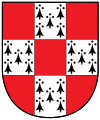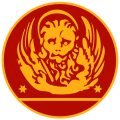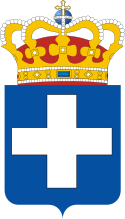Herb Grecji
| ||
 Wersja konstytucyjna | ||
| Warianty | ||
 Wersja wojskowa (używana przez prezydenta i Siły Zbrojne Grecji) | ||
| Informacje | ||
| W oryginale | Εθνόσημο της Ελλάδας | |
| Wprowadzono | 7 czerwca 1975 | |
Herbem Grecji jest biały krzyż na niebieskim tle opleciony gałązkami oliwnymi. Krzyż oznacza przywiązanie do Kościoła prawosławnego, gałązki oliwne symbolizują pokój. Godło to zostało przyjęte w 1975. Na poprzednim, z okresu monarchii, tarcza z krzyżem była zwieńczona koroną królewską.
Historia
- (c) Goran tek-en, CC BY-SA 4.0
Cesarstwo Łacińskie 1204-1261
Królestwo Tesaloniki 1204–1224
- (c) Willtron, CC BY-SA 3.0
Księstwo Aten 1205-1458
Księstwo Neopatrii 1319-1390
Pierwsza Republika Grecka 1822-1832
Król Otto I 1833–1862
Druga Republika Grecka 1924–1935
Herb królestwa 1936–1973
Junta czarnych pułkowników 1967–1974
Władza Wenecji na Wyspach Jońskich 1363–1797
Republika Siedmiu Wysp 1800-1807
Państwo Kreteńskie 1898-1913
Dodekanez Włoski 1912–1945
Zobacz też
Media użyte na tej stronie
Autor: Philly boy92, Licencja: CC0
The coat of arms of the Second Hellenic Republic, as they appeared on the passports at the time.
Autor: Samhanin, Licencja: CC BY 3.0
Coat of Arms of the Principality of Samos (1832-1912)
State Arms of the Kingdom of Greece as used during Glücksburg dynasty (1863-1924 and 1935-1974)
Autor: Heralder, Licencja: CC BY-SA 3.0
Coat of arms of the Duchy of Neopatria
Autor: Madboy74, Licencja: CC BY-SA 4.0
The insignia of Sovereign Military Order of Malta
Reverse of a Greek phoenix coin, bearing the national emblem of Greece, ca. 1830. The words read: "Hellenic State" and the date "1821", referring to the outbreak of the Greek Revolution.
Source: edited & cleared from a PD image of the actual coin
Date: 19 November 2007
Author: Cplakidas
Permission: (Reusing this image) see belowCoat of arms of Greece since 7 June 1975.
Autor: Ta ^specifik^ z W3C grafika wektorowa została stworzona za pomocą Inkscape ., Licencja: CC BY-SA 3.0
The coat of arms of the Cretan States as it appeared on coins.
Presidential and Military variant of the Coat of Arms of Greece
Coat of arms of the Kingdom of Greece in 1936–1973
- Royal Coat of Arms of Greece under the Glücksburg dynasty, created after the restoration of King George II to the throne in 1935, to the exile of King Constantine II in 1967 and finally until the abolition of the monarchy in 1973.
- The Escutcheon features the white cross on a dark blue field of Greece. The Inescutcheon features the Arms of the Greek line of the House of Schleswig-Holstein-Sonderburg-Glücksburg. The shield is then topped with a golden Royal Crown.
- It features an escutcheon divided by the red and white cross of the Order of the Danneborg, the first quarter features the arms of Denmark (three crowned blue lions and nine hearts in yellow field). The second of Schleswig (two blue lions passant in yellow field). The third divided into four; the chief features the three royal crowns in blue field of Sweden, the second half with a crowned stockfish on red field of Iceland and the last half divided between the ram of the Faroe Islands and a polar bear of Greenland, both on blue fields. The fourth quarter is divided between two halves, the chief depicts a yellow field with a blue lion passant over nine red hearts of the King of the Goths, the lower half depicts a crowned golden lindorm on a red field of the King of the Wends.
- Upon it is another inescutcheon in red, divided into four quarters: the first a a silver nettle leaf of Holstein, the second the a swan with a golden crown of Stormarn, the third a knight dressed in golden armor on a silver horse of Dithmarschen and the fourth of a golden horse's head of Lauenburg.
- Upon it is another inescutcheon divided the first features the red and yellow bars of Oldenburg, the second a golden cross on a blue field of Delmenhorst.
- The escutcheon rests on a golden pedestal and supported by two human figures representing the Greek mythological hero Herakles (Hercules), holding a wooden club and wearing the skin of the Nemean lion.
- The escutcheon is surrounded by the ribbon and cross of the Order of the Redeemer, the cross depicts Christ Pantocrator, surrounded by the order's motto:"Η ΔΕΞΙΑ ΣΟΥ ΧΕΙΡ, ΚΥΡΙΕ, ΔΕΔΟΞΑΣΤΑΙ ΕΝ ΙΣΧΥΙ" or "Thy right hand, O Lord, is become glorious in power" from Exodus, 15:6.
- The motto of the Coat of arms and of the dynasty, depicted on a golden ribbon below the pedestal reads: "Ἰσχύς μου ἡ ἀγάπη τοῦ λαοῦ" or "The people's love, my strength"
- The coat of arms is then surrounded by a dark blue mantle and topped with another royal crown.
Emblem of the defunct state, Septinsular Republic which existed from 1800-1815
The coat of arms of the Kingdom of Thessalonica
State and Royal Coat of Arms of the Kingdom of Greece as used during the House of Wittelsbach (1832–1862)
Autor: Facquis, Licencja: CC BY-SA 4.0
Stemma dell'impero latino reso dall'immagine File:LDAM_(f._012)_Rei_de_Constantinopla.jpg
(c) Goran tek-en, CC BY-SA 4.0
The Byzantine double-headed eagle with the sympilema (the family cypher) of the Palaiologos dynasty.



































